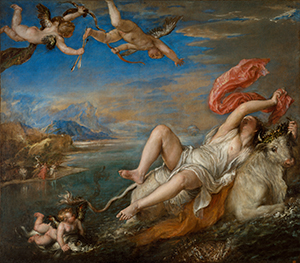Temporarily works for the first time in 119 years of existence
The epic series of large-scale mythological paintings by Titian, From the original cycle of six paintings, the exhibition will bring together Danaë (1551-1333, The Wellington Collection, Apsley House); Venus and Adonis (1554, Prado, Madrid); Diana and Actaeon (1556-159) and Diana and Callisto (1556-159), owned jointly by the National Gallery and the National Galleries of Scotland; and the recently preserved Rape of Europa (1562) from the Isabella Stewart Gardner Museum, Boston.
Following its historic decision to temporarily lend artwork for the first time in 119 years of existence, the Wallace Collection lends its paintings from the Perseus and Andromeda cycle (1554-156) to the Trafalgar Square exhibition. Death of Actaeon (1559-1575), a museum of the National Gallery, originally designed to be part of the series, but executed much later and never delivered, will also be on display in London. All paintings revolve around love and desire: their fruits and perils. Combining Titian's remarkable talent as an artist and storyteller, mythological scenes capture dramatic moments; a fatal encounter, a shameful discovery, a hasty abduction. In these paintings, Titian skillfully manipulates painting and color to achieve a dazzling effect. capturing luminous flesh, sumptuous fabrics, water and reflections, as well as atmospheric landscapes almost enchanted. His characters show very human and relatable emotions: euphoria, anxiety, guilt, surprise, shame, despair, anguish and terror. The paintings describe stories of classical mythology, mainly drawn from the Metamorphoses of the Roman poet Ovid. Because he considered them as visual equivalents to poetry, Titian called them his "poetry". He developed the knowledge of painting and visual narrative that he had acquired in five decades as an artist to create some of his deepest claims about human passion and irrationality, about love and death . The series was commissioned by Philip II of Spain, who gave Titian an open mandate to choose his subjects. The letters between Titian and Philip show that poetry was expected to be collected in one room, but since Philip was constantly changing residency during their creation, it was unlikely that the client would think of a specific destination for the group. . The paintings are an excellent example of a great artist in rare agreement with a sensitive patron, continuing to grow and deepen his artistic perspectives into his older years. Shortly after completing Diana and Actaeon, Titian began a sequel for Philip showing the tragic conclusion of the story: The Death of Actaeon. Although he initially designed this image as part of the series, he never sent it to Phillip. He worked there later, probably in the 1560s or early 1570s, but we do not know for whom. He may have stayed in his studio until his death in 1576. The four others, Perseus and Andromeda, Rape of Europa, Diana and Callisto, and Diana and Actaeon, as well as the unfinished The Death of Actaeon, passed through different paths in the collection of Philip II, Duke of Orleans (1674- 1723). When this collection was auctioned in London in 1798, the five poems were divided but remained in the British collections throughout the 19th century. Perseus and Andromeda were unsold at the first sale, then changed hands before being sold at the second sale by the Duke of Orleans in 1805. All poems were therefore in the UK at some point and several times to Perseus and Andromeda. The first time Van Dyck brought it to London shortly after 1623. The exceptional quality of poetry attracted rich collectors overseas, and in 1896 Rape of Europa was sold to Isabella Stewart Gardner for her collection in Boston, USA. However, Perseus and Andromeda are acquired for Great Britain the following year as part of the legacy of the Wallace Collection. In 1972, when The Death of Actaeon went on sale, the National Gallery bought the painting successfully, thanks to government funding and a nationwide appeal. In 2009, the National Gallery and the National Galleries of Scotland jointly acquired Diana and Actaeon; and in 2012, Diana and Callisto, securing the last two masterpieces to the public. Matthias Wivel, curator of 16th-century Italian paintings at the Titian National Gallery and Curatorial Gallery: Love Desire Death, says: "For many painting lovers, it's about realizing a dream that was thought impossible . The paintings are so powerful individually that it is difficult for me to overestimate the effect of seeing them together. " Dr. Gabriele Finaldi, director of the National Gallery, said: "Unthinkable until today, for the first time in more than four centuries, thanks to the loan of Titian Perseus and Andromeda by the Wallace collection, all the mythologies from the poetry of the artist handed over to the King of Spain will be seen together, as he wished. I'm glad it happens at the National Gallery. " Matthew Moore, President and CEO of Liberty Specialty Markets, said, "We are proud to support the show. We are one of the world's leading providers of specialized insurance coverage for Fine Art and Specie collections. We understand how important it is to preserve and nurture these pieces of history so that we can enjoy them as well as future generations. This is a unique opportunity to see the six paintings in one place and I look forward to seeing them. " The exhibition will visit the Scottish National Gallery, Edinburgh Perseus and Andromeda is only confirmed for London at present. The exhibition is curated by Dr. Matthias Wivel, curator of 16th century Italian paintings at the National Gallery in London. Exhibition sponsored by Supporté by Moretti Fine Art Ltd The Sunley exhibition program is supported by the Bernard Sunley Foundation Image - Titian, Rape of Europe, 1562 © Isabella Stewart Gardner Museum, Boston Admission fees Prices vary Book in advance and save Reservation - tickets on sale About Liberty Specialty Markets For more information, please contact the press service of the
|
|---|


